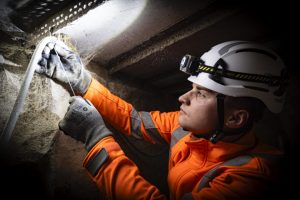The fight against falls
Falls from height remain leading cause of workplace fatality. Louise Charlton looks at how you can mitigate the risk of working at height.

THE LATEST statistics released by the Health and Safety Executive (HSE) revealed that 35 workers lost their lives following a fall from height in Great Britain during 2024/25, accounting for more than a quarter of all fatalities.
Falls have been the leading cause of fatal injuries almost every year since 2001/02. This year’s figures show a reduction compared to last year and put the number slightly below the five-year average. However there is still more to be done to keep those working at height safe.
Risk remains heavily dependent on industry. For the last five years, over half of all construction deaths were caused by falls from height, averaging 21 each year. Whereas in manufacturing, agriculture, forestry and fishing, the average is around four deaths per year.
Work at height in any sector requires thorough planning. Equipment selection and training must take into account the hazards presented, ensuring workers have the skills and gear they need to carry out the work safely.
Planning
Protecting your staff begins in the planning stages. A risk assessment must be conducted to identify all potential hazards. It is important to complete a method statement and obtain work permits where applicable prior to starting any job.
Planning for work at height should follow the hierarchy of control, aiming to eliminate or minimise risks before relying on a fall arrest system.
Avoid – First consider whether the task can be done safely from the ground.
Prevent – Using a safe place to work from – e.g. a mobile elevating work platform – or restraint equipment can prevent a fall from occurring.
Minimise – If the fall risk remains, minimise the distance and/or consequences of the fall using work equipment or personal fall protection equipment (PFPE).
Training
Regular training is vital to ensure staff understand how to work safely and use fall protection equipment correctly.
The Work at Height Regulations 2005 state that workers must be ‘competent’ to carry out the relevant work. To be considered competent each operative needs sufficient skills, knowledge and experience to perform the relevant tasks safely. While in training, staff must be supervised by a competent person.
For a low-risk, short duration task using ladders, providing instructions on how to use ladders safely and appropriate training for the task may be enough to ensure competency. However some work involves a more technical level of competence, and industry certification may be required for certain tasks.
Those responsible for rescue need to know how to use rescue equipment in different scenarios while keeping themselves safe. Training should cover casualty care and suspension trauma, instructing people on how to care for the rescued operative and protect them against further injury.
Work at height training should also cover inspection and maintenance of PFPE. Frequency may depend on the job role, with those who work in more higher risk applications requiring training more often.
Fall protection equipment
Work at height requires specialist equipment to keep workers safe. PFPE can be set up in different ways depending on the task. Details such as the free space below the fall hazard, presence of sharp edges, and suitability needs for the wearer are important to consider when selecting equipment.
Fall protection systems can be set up in a number of ways:
Work restraint – A work restraint system prevents the wearer from reaching zones that present a fall risk. The equipment is set up to physically stop the wearer before they can reach a fall edge. This eliminates the hazard and should be selected over a fall arrest system wherever possible.
Work positioning – A work positioning system enables a person to work supported by PFPE in tension, preventing a free fall. The work positioning device can entirely support the wearer or provide partial support in conjunction with other equipment.
Fall arrest – A fall arrest system is designed to arrest a fall if it occurs. The equipment absorbs energy and applies deceleration through a specified arrest distance, limiting the wearer’s risk of serious injury. Where possible, a work restraint system is preferable to eliminate the fall risk altogether.
Rope access – This is a form of work positioning derived from techniques used in climbing and caving. Rope access technicians descend, ascend and traverse ropes whilst suspended in their harness. The rope support is intended to eliminate fall risk, but a fall arrest system should always be used as a redundancy system – this can be achieved using two ropes, a movement line and a safety line.
When selecting equipment, it is necessary to assess the free space beneath a fall hazard. There must be enough space to prevent the wearer reaching the ground or another structure in the event of a fall.
The required fall clearance depends on the type of equipment you are using. In every circumstance, the height of the wearer and recommended safety clearance must be factored in.
The distance from the connection point to the wearer’s feet following a fall is typically taken as 2m. This accounts for the wearer’s height and potential harness stretch. Fall arrest systems must also allow an additional 1m safety clearance.
The position of the anchor point is another important consideration. Where the anchor point is positioned in relation to the operative affects the potential fall distance and determines the fall factor.
Current EN standards only require vertical testing. To be suitable for horizontal use, specialist assessment is needed. When a fall over an edge occurs, slippage can increase braking force above the safe limit of 6kN. The fall may still be arrested but the higher braking force could injure the wearer.
Sharp edges, such as on terraced roofs, also pose a risk of cutting the connection and causing the system to fail. Recommendations for Use sheets (RFUs) published by the VG11 Notified Bodies group outline test methods to assess equipment in horizontal configurations and sharp edge applications.
Future standards may be updated to include these tests however, in the meantime, check for the relevant VG11 CNB references to make sure equipment is suitable for horizontal use.
Compliance, inspection and maintenance
PFPE is designed to save lives. It must be appropriately tested and certified to make sure it can do its job, so wearers can do theirs safely.
As Category 3 products under the PPE Regulation 2016/425, there are strict testing and certification procedures to make sure height safety equipment is safe for use. It is critical to check products are fully compliant.
Non-compliant, substandard PPE sourced from online marketplaces poses a real threat to workers. A 2021 test purchasing programme carried out by the Office for Product Safety and Standards (OPSS) found that almost 90% of Category 3 PPE products were non-compliant. Out of 315 products tested, including climbing harnesses, only 39 passed the relevant assessments.
The new Product Regulation and Metrology bill should give market surveillance authorities greater regulatory powers to combat non-conforming products being sold online. However, in the meantime, it is more important than ever to buy from established brands and check documentation to confirm compliance.
|
CE / UKCA Certificate |
Issued by independent certification body |
Details full conformity and compliance information |
|
Declaration of Conformity (DOC) |
Issued by manufacturer |
Lists standards the product has been tested and certified to, and includes CE/UKCA certificate number |
|
Certificate of Conformity (COC) |
Issued by manufacturer |
Confirms the testing performed to ensure conformity of the specific production batch |
Regular inspection is essential to ensure fall protection equipment is maintained in good working order. EN standards include a requirement for periodic examination, which must be carried out at regular intervals, often once a year.
Pre-use checks are required each time equipment is used to make sure products are in good working order and free from damage. Mechanical devices have additional requirements for servicing, which must be carried out by properly trained agents who have been authorised by the equipment manufacturer.
All PFPE has a shelf and working life that must not be exceeded. Check the user instruction leaflet to confirm your equipment is in date. The user instructions also contain important guidance on how to set up fall protection systems and ensure they are safe for use.
This year’s HSE statistics highlight the degree of risk involved when working at height. While 2024/25 saw a reduction in fatalities compared to last year, the 35 lives lost remain a stark reminder of the potential consequences of a fall from height and the need to ensure staff are protected. Carefully assessing the hazards, providing regular training, and selecting appropriate, fully compliant equipment helps to mitigate fall risks and make sure everyone returns home safely.
Louise Chalton is technical copywriter at JSP Safety. For more information, visit jspsafety.com.
Note: Injury data taken from Work-related fatal injuries in Great Britain 2025 published by HSE
HSM publishes a weekly eNewsletter, delivering a carefully chosen selection of the latest stories straight to your inbox.
Subscribe here





